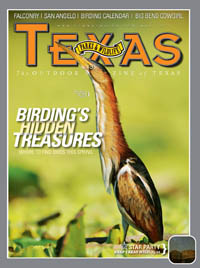
Cane Invasion
A harmless wasp could replace digging and herbicides in the fight against unwanted cane.
By Melissa Gaskill
A few years ago while canoeing through Big Bend, I tangled with a heartless invader. On a bend of the Rio Grande, the current caught my canoe and, despite my frantic paddling, sent it directly into a thick snarl of Arundo donax. I came out the other side covered in leaves, twigs and a spider or two, my hat knocked off, hands scratched and sleeve torn.
This invasive cane, native to Asia and cultivated in Europe, was used by settlers to thatch roofs, says Travis Gallo, researcher with the University of Texas Lady Bird Johnson Wildflower Center. Introduced here for use in erosion control and as an ornamental, the prolific plant now sprouts all over the state along ditches, streams and rivers.
It wreaks far more havoc than the scratches I got in my brief encounter.
Arundo creates a monoculture, says Gallo, crowding out tree saplings and other native plants. The cane effectively reduces wildlife habitat by using up water and nutrients.
Few birds use it for nesting, and it does not provide food for wildlife.
The cane outcompetes other vegetation for water, says Michael Murphrey, East Texas invasive species coordinator for the Texas Forest Service. Dense stands also choke stream channels and interfere with flood control, and can dam up debris, causing damage to bridges and culverts.
UT researchers have investigated wasps that attack the cane by creating galls that may stress the plants and reduce their significant competitive advantage. Testing shows that the wasp feeds and completes its life cycle only on Arundo and so does not pose a threat to any native or economically important plants. The tiny wasp also does not sting or harm humans, livestock or wildlife.
According to the U.S. Department of Agriculture’s Agricultural Research Service, the wasp could save as much as $30 million in the form of decreased cane control costs and increased water conservation from reducing the cane. Wasp releases began in 2009 in Laredo. The weak fliers do not move far, and scientists are closely monitoring the populations, which they hope will become self-sustaining.
Controlling an invasive species first requires knowing where it is, though. Gallo coordinates the Invaders of Texas program, a collaboration of the Wildflower Center, TPWD, the Texas Forest Service and other organizations, using some 900 volunteers statewide to report the whereabouts of 140 invasive species.
“Having a master list means everyone can work off the same one,” says Murphrey, who also works with the citizen scientist effort. “The reasoning behind the whole citizen science and Texas invasives push is that no one entity is doing it. So we all put together an initiative to help stop the spread.”
The invaders program recently partnered with Austin’s watershed protection department to eradicate cane on Lady Bird Lake. Mary Gilroy, Austin environmental scientist, says that once Arundo locations have been mapped, the city will determine the best methods of control, implement them and then restore treated areas with native vegetation.
Gilroy’s research seems to show that the best approach is to cut down the cane, allow some regrowth and then apply herbicide.
“But we haven’t determined if that’s the way we’re going to go,” she says. “Lots of these plants are close to the water, and the Austin watershed protection people spend a lot of time trying to keep pollutants out of the water. At the same time, we have to evaluate what mechanical effort alone can do. It’s more expensive, takes more intense work, and we don’t know how effective it will be.”
The cane grows readily from just a tiny fragment of plant and spreads by rhizomes, as does bamboo, which makes it easy for a small stand of cane to become a large one. Murphrey highly recommends that anyone finding cane on his or her property kill it immediately. “All it has to do is get a start and then you have it everywhere. Get it while it’s small.”
Murphrey doesn’t believe laws requiring the cane’s removal are the answer.
“It’s up to all of us to fix the problem,” says Murphrey. “With herbicides, you have to double-check and re-treat to make sure you got it all. If you’re against herbicides, then you’ll have to dig. Arundo is very deep-rooted, and you’re going to dig a lot. But how do you eat an elephant? One bite at a time.”
Find out more about invasive species at www.texasinvasives.org

